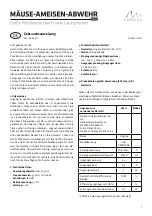
Denver
English
24
05060085 01 13/07/2010
11.Loading the cabinet (Fig. 7)
When stocking the cabinet the following important rules must be observed:
- uniformly arrange the merchandise and never exceed the loading line (Rif. 10) to prevent the
interruption of correct air circulation (Rif. 9) that would cause an increase in the temperature and
formation of ice on the evaporator.
- uniformly arranging the merchandise without empty areas guarantees better cabinet function;
- it is recommended that old merchandise on display
in the cabinet is sold before new stock (food
products rotation).
12.Defrosting and water draining
The Denver refrigerating cabinets line is equipped with an off cycle defrosting system that stops the
refrigeration cycle. (Ventilated Denver
Defrosts 4 times a day, 40 minutes each
):
Version with built in/ remote unit:
The defrosting water is collected by a suitable drain and conveyed to a tray located at the base of the
cabinet. For practical reasons, a floor drain is recommended.
Version with remote unit:
In order to evacuate the the water after defrosting it is necessary:
- to foresee a floor drain with slight inclination;
- hermetically seal the area of the floor drain.
This way bad smells inside the cabinet, the dispersion of refrigerated air and possible malfunction of
the cabinet due to humidity can be prevented.
N.B.Periodically check the perfect efficiency of the hydraulic connections by referring to a qua-
lified installer.
13.Anti-mist and anti- condensate
The cabinet is provided with hot cables for eliminating any condensate and mist phenomenons.
14.Lighting
A florescent lamp is used for the internal light of the cabinet.
The lights switch is located on the electric control board indicated in Fig. 6 Rif. 5(2).
15.Maintenance and cleaning (Fig. 4)
Food products can deteriorate due to microbes and bacteria.
Respecting hygiene norms is indispensable in order to guarantee protection of consumer health, as
well as respecting the chain of refrigeration, for which the sales point is the last controllable ring.
Cleaning of refrigeration units should be carried out as follows:
Cleaning of external parts (Daily / Weekly)
- On a weekly basis, clean the external parts of the unit, using neutral household detergents or soap
and water.
- Rinse with clean water and dry with a soft cloth.
- DO NOT use abrasive products or solvents that can affect the unit surface.
- DO NOT spray water or detergent directly on the electrical parts of the unit.
- DO NOT touch the unit with wet or damp hands or feet
- DO NOT use the unit if barefoot
- DO NOT use alcohol to clean the methacrylate parts (Plexiglas).
Cleaning of internal parts (Monthly)
Cleaning the unit's internal parts is done to destroy pathogenic micro-organisms so as to ensure
protection of merchandise.
Before beginning to clean the inside of the unit, it is necessary to:
- Completely remove all merchandise inside;
- Disconnect the unit's power supply using the main switch;
- Remove any removable parts, including display plates, grills, etc. These should be washed with
warm water and detergent that contains disinfectant, and then dried carefully;
- Carefully clean the tank, drip, and water discharge protection grill, eliminating all foreign bodies that
ATTENTION!: BEFORE CARRYING OUT ANY MAINTENANCE WORK OR
CLEANING, FIRST DISCONNECT THE UNIT FROM THE VOLTAGE SUPPLY
BY MEANS OF THE GENERAL SWITCH. ALWAYS WEAR PROTECTIVE
GLOVES FOR CLEANING.
















































